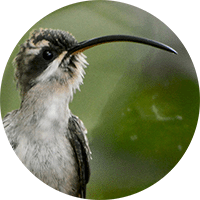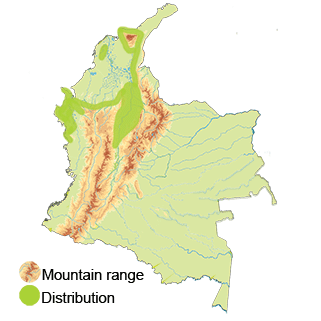Long-billed Hermit
The Long-billed Hermit (Phaethornis longirostris) Read in Spanish
Appearance: The Long-billed Hermit is characterized by its long, slightly curved bill, which is adapted for feeding on nectar from flowers. It has a dark olive-green plumage, a white throat, and a slightly rufous-tinged belly. The tail is long and forked, with white tips on the outer feathers.
Habitat: This species predominantly inhabits humid forests, including primary and secondary forests, as well as forest edges and clearings. They are typically found in the lowlands and foothills, especially in areas with dense vegetation and abundant flowering plants.
Behavior: Long-billed Hermits are known for their solitary and territorial nature. They feed on the nectar of flowers using their specialized bills and also consume small insects for additional protein. These birds are often observed hovering near flowers or perching quietly in the dense understory of the forest.
Breeding: During the breeding season, males perform elaborate courtship displays to attract females. Nests are constructed by the female using plant fibers and placed in a hidden location within the forest. The female typically lays two eggs, which she incubates alone.
Conservation Status: The conservation status of the Long-billed Hermit in Colombia is generally of least concern.
Distribution
The Long-billed Hermit (Phaethornis longirostris)
Coastal Region: The Long-billed Hermit can be found in the coastal regions of Colombia, including areas along the Caribbean coast and the Pacific coast. These coastal areas provide habitats such as humid forests, mangroves, and forest edges where this hummingbird species can thrive.
Western Andes: The Long-billed Hermit is also found in the western part of the Andes mountain range in Colombia. This region includes areas such as the Pacific slope of the Andes, where the bird can inhabit montane forests and cloud forests at higher elevations.
Northern Andes: In the northern part of the Andes range, including regions like the Sierra Nevada de Santa Marta and the Eastern Cordillera, the Long-billed Hermit can be found in suitable habitats such as humid forests and forest edges.
Taxonomy
The Long-billed Hermit ( Phaethornis longirostris)
- Kingdom: Animalia
- Phylum: Chordata
- Class: Aves (Birds)
- Order: Caprimulgiformes
- Family: Trochilidae
- Genus: Phaethornis
- Species: Phaethornis longirostris
Vocalization
The Long-billed Hermit (Phaethornis longirostris)
- Song: The male Long-billed Hermit uses its vocalizations, often characterized by a series of high-pitched chirps, buzzes, or trills, as part of its courtship displays. These songs may vary in complexity but generally involve rapid sequences of notes that help attract mates and establish dominance in their territory.
- Calls: Long-billed Hermits also produce different types of calls for communication purposes. These calls can include short, sharp notes, buzzing sounds, or trills that are used to signal alarm, aggression, or to maintain contact with other individuals in their habitat.
- Territorial Defense: Vocalizations play a significant role in marking territories and defending them against intruders. Long-billed Hermits may use specific vocal cues to ward off rivals and assert their dominance within their territory.
- Communication: Beyond courtship and territorial behaviors, Long-billed Hermits use vocalizations for general communication with other individuals in their environment. These vocal signals help establish social hierarchies, coordinate group movements, and convey various messages among members of their species.





